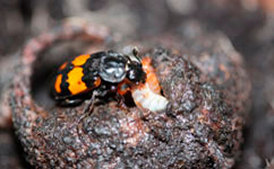Parental care and mating behaviour in "burying beetles"
|
Currently I am part of a project focused in the evolution of patterns of mating behaviour and parental care in "burying beetles", Nicrophorus vespilloides. The burying beetles are characterized for performing a sophisticated parental care, like mammals or birds, and show a set of behaviours to attract a mate. Our questions are addressed to understand the co-evolution of these traits into the context of family conflicts.
|
G-matrix of life histories in a cyclically parthenogenetic aphid
|
Organisms with coexisting sexual and asexual populations (i.e. aphids) are ideal models for studying the consequences of either reproductive mode on the quantitative genetic architecture of life-history traits. Beacause of the trade-offs may change across time and spatial between populations, putatively leading to different evolutionary trajectories. In this conext, we studied the primary role of climate in shaping the reproductive variation and energetic cost in the bird cherry-oat aphid (Rhopalosiphum padi).
|
Anti-predator phenotypic plasticity in Daphnia
|
Inducible, anti-predator traits are a classic example of phenotypic plasticity. The evolutionary dynamics of inducible, anti-predator traits depend on their genetic basis and the historical pattern of predation risk that populations have experienced. When populations experience, for example, predators with different in hunting strategies and size preferences, we would predict contrasting patterns of selection and of genetic covariance among defence traits. From different ecological and evolutionary approaches we have studied this anti-predator strategy in different species of Daphnids (Daphnia ambigua and Daphnia pulex).
|
Phylogeography and Ecophysiology of Spalacopus cyanus ("The cururo")
|
Spalacopus cyanus is a subterranean rodent inhabiting coastal and mountain of central Chile (South-america). The "cururos" are endemic rodents characterized by living in small groups with particular adaptations to subterranean environments. From of an ecophysiological view we studied the energetic costs associated to the burrowing activity and thermal constraint to live in subterranean environments. Also, under a phylogeographic approach we investigated the genetic structure and biogeography of this species.
|
Transgenerational effects on life-history traits in a terrestrial isopods
|
The maternal effects has been recognized to be an important influence on offspring performance, which is relevant to animals with direct development including a maternal care periods. Using a terrestrial isopods Porcellio laevis we studied the life-history traits, individuals performance and genetic architecture from animals under different nutrional regimes. We found: i) The life-history correlations are context dependant, ii) an strong association between maternal body size and metabolic offspring perfomance, iii) and how an environmentally driven evolutionary process could occur in nature, since the response to selection could change dramatically according to the diet that mothers are ingesting.
|





